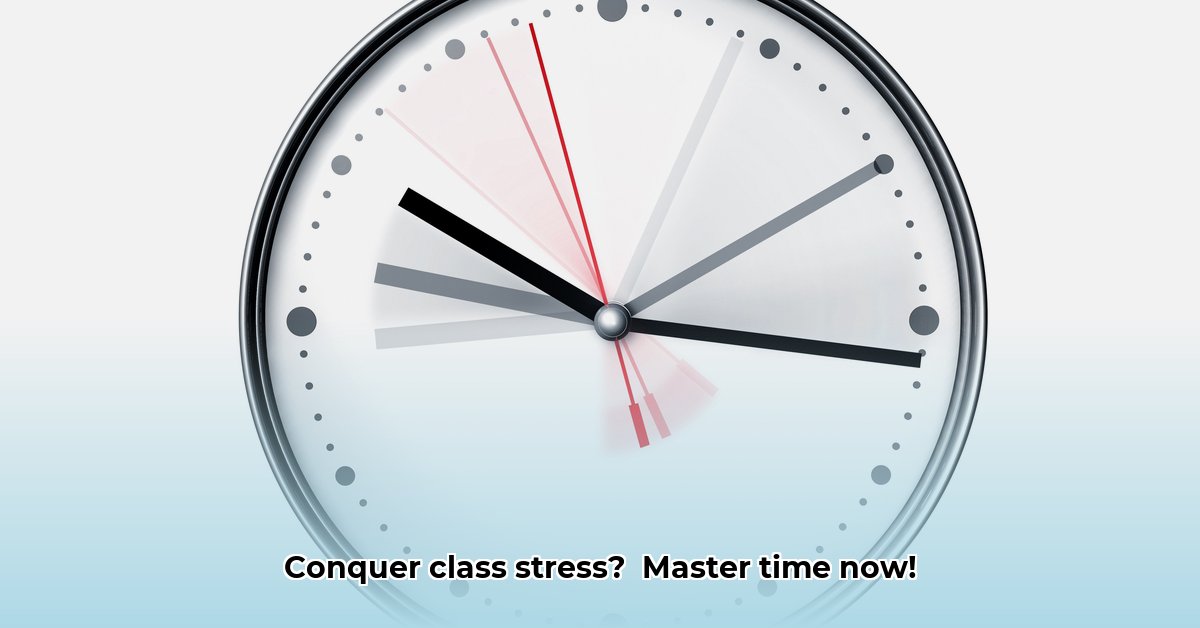Teaching is an amazing profession, but it’s also incredibly demanding. Balancing lesson planning, grading, parent meetings, and a myriad of other responsibilities can easily lead to feeling overwhelmed. For additional time management tips, check out these student time management tips. This guide provides practical, actionable strategies to effectively manage your time in the classroom, reduce stress, boost productivity, and rediscover the joy of teaching. From prioritizing tasks to creating a sustainable system, you’ll learn how to take control of your schedule and create a fulfilling and balanced teaching life. Let’s get started!
Time Management Strategies to Reclaim Your Day
The life of a teacher is often compared to a marathon, not a sprint. The constant juggling of lesson plans, grading, parent communication, and administrative tasks can leave you feeling drained and stretched thin. However, effective time management isn’t about working harder; it’s about working smarter and enhancing your teacher wellbeing. This guide provides practical strategies to reclaim your time and energy, improve your time management skills, and prioritize your wellbeing. Studies show that teachers who actively manage their time report a significant decrease in stress levels and a greater sense of control over their workload.
Getting Real About Your Time: Conducting a Time Audit
Before implementing any changes, it’s crucial to understand how you’re currently using your time. For one week, conduct a detailed time audit, documenting every activity, including lesson planning, grading, meetings, student interactions, and breaks. Be honest and specific, noting the duration of each task and any distractions encountered.
After the audit, analyze your findings to identify time-wasting activities, such as excessive social media use, unproductive meetings, or inefficient grading processes. Once you pinpoint these time-suckers, you can develop strategies to minimize or eliminate them, streamlining your workflow and freeing up valuable time.
Prioritizing Like a Pro: Leveraging the Power of the 80/20 Rule
The Pareto Principle, also known as the 80/20 rule, states that 80% of your results come from 20% of your efforts. In the context of teaching, this means that a small number of tasks have a disproportionately large impact on student learning and overall classroom success. Identify those crucial activities, such as delivering engaging lessons, providing personalized feedback, and building strong relationships with students, and make them your top priority.
This doesn’t mean neglecting other responsibilities, but it does mean allocating your time and energy strategically. Focus on the highest-impact activities first, when your energy levels are highest, and delegate or postpone less critical tasks. Research suggests that focusing on high-impact tasks can lead to a significant improvement in student engagement and academic performance.
Batching Tasks: Streamlining Your Workflow
Batching involves grouping similar tasks together and completing them in a single block of time. For example, instead of grading a few papers each day, dedicate a specific time slot to grading all papers at once. Similarly, you can batch lesson planning, email correspondence, and administrative tasks.
Batching reduces mental “switching costs,” the time and energy it takes to shift your focus from one task to another. By concentrating on a single type of activity, you minimize distractions, improve focus, and accomplish more in less time. This simple strategy can significantly enhance your daily workflow and free up valuable time for other priorities.
The Art of Saying “No”: Protecting Your Time and Energy
Setting healthy boundaries is essential for preventing burnout and maintaining a sustainable work-life balance. While it’s admirable to be a team player and volunteer for extra responsibilities, overcommitting yourself can lead to exhaustion and decreased effectiveness.
It’s okay to politely decline additional tasks or commitments if you’re already feeling overwhelmed. Prioritize your well-being and protect your time for what truly matters: your students and your personal life. Teachers who set firm boundaries report a significant reduction in feelings of overwhelm and a greater sense of control over their schedules.
Tech to the Rescue: Utilizing Technology for Efficiency
Technology can be a powerful tool for streamlining your workload and improving efficiency. Explore educational apps, software, and online platforms designed to simplify tasks such as grading, lesson planning, communication, and assessment.
Experiment with different options to find the tools that best suit your needs and preferences. The right technology can save you significant time and effort, allowing you to focus on more meaningful interactions with your students.
Practical Strategies for Better Classroom Time Management
Here are some specific, actionable strategies you can implement immediately to improve your classroom time management:
- Detailed Lesson Plans: Well-structured lesson plans minimize on-the-spot improvisation, keeping you on track and ensuring that you cover all essential content.
- Crystal-Clear Learning Objectives: Clearly defined learning objectives provide a roadmap for each lesson, helping you stay focused and preventing digressions.
- Engaging Activities: Actively engage students in the learning process to minimize disruptions and wasted time.
- Smooth Transitions: Plan efficient transitions between activities to avoid lulls and maintain momentum.
- Strategic Breaks: Incorporate short, structured breaks into your schedule to maintain energy levels and prevent burnout.
Building a Sustainable System: The Long Game
Mastering time management is an ongoing process, not a one-time fix. It’s about finding a system that works best for you and then continually adjusting it as your needs and priorities change.
Regularly review your strategies and identify areas for improvement. Be flexible and adaptable, willing to experiment with new techniques and approaches. Consider professional development opportunities that focus on time management, stress reduction, and self-care.
By implementing these strategies, you’ll not only improve your classroom time management but also reduce stress, enhance your well-being, and rediscover the joy of teaching. You deserve to thrive both professionally and personally.
Mastering the Juggle: Balancing Lesson Planning, Grading, and Emotional Labor
Teaching is a multifaceted profession, demanding a wide range of skills and responsibilities. Balancing lesson planning, grading, and the emotional labor of supporting students can feel overwhelming. However, with effective planning, streamlined processes, and a focus on self-care, you can manage these demands and create a sustainable and fulfilling teaching career.
Key Takeaways:
- Effective time management is essential for managing multiple demands and reducing stress.
- Prioritizing tasks and streamlining processes can free up time for meaningful interactions with students.
- Acknowledging and addressing the emotional labor of teaching is crucial for preventing burnout.
- Technology can be a powerful tool for improving efficiency and organization.
- Self-care is not a luxury but a necessity for maintaining well-being and effectiveness.
Planning Your Time: The Foundation of Success
Effective planning is the cornerstone of successful time management. By taking the time to plan your week and day, you can create a framework for managing your workload and prioritizing your responsibilities.
- Weekly Overview: Begin each week by creating a high-level plan that includes major deadlines, meetings, and upcoming events.
- Daily Prioritization: Use a system like the Eisenhower Matrix to prioritize your daily tasks, focusing on the most important and urgent items.
- Time Blocking: Allocate specific time slots for different activities, creating structure and helping you stay on track.
Streamlining Lesson Planning
Lesson planning is a critical aspect of teaching, but it doesn’t have to consume your entire week. Here are some strategies for optimizing your lesson planning process:
- Repurpose Materials: Adapt and reuse successful lessons from previous years, saving time and effort.
- Template Power: Create lesson plan templates to ensure consistency and streamline the planning process.
- Batch Similar Tasks: Group similar lesson planning tasks together, such as creating all assessments for the week in a single block of time.
Tackling Grading Efficiently
Grading can be a time-consuming and often tedious task. However, there are ways to make it more efficient and less overwhelming:
- Smart Technology: Explore online grading platforms that can automate certain tasks and provide valuable data insights.
- Strategic Feedback: Focus on providing high-impact feedback, prioritizing the most critical areas for improvement.
- Delegate When Possible: Involve teaching assistants or student peer reviewers in the grading process, if possible.
Managing Emotional Labor
Teaching is an emotionally demanding profession. Supporting students, managing classroom dynamics, and dealing with challenging situations can take a toll on your emotional well-being. Acknowledge and address the emotional labor of teaching by:
- Prioritizing Self-Care: Schedule time for self-care activities, such as exercise, relaxation, and spending time with loved ones.
- Setting Boundaries: Learn to say “no” to extra commitments and protect your time and energy.
- Connecting with Colleagues: Share your experiences and challenges with fellow teachers, building a supportive network.
Technology as Your Ally
Technology can be a valuable tool for managing your workload and improving efficiency. Consider using the following types of tools:
| Tool Category | Example Tools | Benefits |
|---|---|---|
| Lesson Planning | Google Docs, Canva, PowerPoint | Organization, collaboration, visual aids |
| Grading | Google Classroom, Gradescope | Automated feedback, efficiency |
| Communication | Email, Remind, ClassDojo | Streamlined communication |
| Task Management | Google Calendar, Trello, Asana | Organization, prioritization |
Remember, the goal is to work smarter, not more. By implementing these strategies, you can reclaim your time, reduce stress, and create a more fulfilling and sustainable teaching career.
Proven Tactics To Batch Similar Tasks For Ultimate Teacher Productivity
Batching, the practice of grouping similar tasks together and completing them in a single session, is a powerful time management technique that can significantly boost teacher productivity. By minimizing task switching and maximizing focus, batching helps you accomplish more in less time, reducing stress and freeing up valuable time for other priorities.
Key Takeaways:
- Batching involves grouping similar tasks together to minimize task switching and maximize focus.
- Planning is essential for identifying batchable tasks and scheduling dedicated time blocks.
- Consistency is key to reaping the long-term benefits of batching.
- Adapt your batching system to suit your individual needs and preferences.
- Technology can enhance the effectiveness of your batching system.
Identifying Your Batchable Tasks
The first step in implementing a batching system is to identify tasks that lend themselves to this approach. Consider the repetitive activities that consume your time, such as:
- Lesson planning
- Grading papers
- Emailing parents
- Creating assessments
- Preparing materials
These tasks are all prime candidates for batch processing.
Planning Your Batching Strategy
Once you’ve identified your batchable tasks, it’s time to develop a plan for implementing your batching system:
- Create a Master Task List: Write down every task you perform, including even the smallest and seemingly insignificant ones.
- Categorize Similar Tasks: Group similar tasks together, such as all grading tasks or all lesson planning tasks.
- Schedule Dedicated Time Blocks: Allocate specific time slots in your day or week for each batch.
- Prioritize: Decide which tasks are most important and time-consuming, and tackle those batches first.
- Be Realistic: Don’t overschedule yourself. Start small with one or two batches and gradually increase as you become more comfortable.
Implementing Your Batching System
Now it’s time to put your plan into action. Consistency is key to making batching work.
- Eliminate Distractions: Turn off notifications, find a quiet space, and focus intently on the task at hand.
- Set Time Limits: Avoid burnout by setting realistic time limits for each batch.
- Take Breaks: Short, regular breaks can help maintain focus and prevent mental fatigue.
- Track Your Progress: Monitor how long each batch actually takes. This helps you fine-tune your schedule over time.
Adapting and Refining Your Approach
Batching isn’t a one-size-fits-all solution. What works for one teacher might not work for another. Be prepared to experiment and adjust your system to find what works best for you.
- Experiment with Different Batch Sizes: Some teachers find it easier to batch many similar tasks, while others prefer smaller batches.
- Regularly Review and Adjust: Analyze what’s working and what’s not, and be open to changing your approach to improve efficiency.
- Don’t Be Afraid to Delegate: If applicable, delegate tasks that can be handled by others, freeing up your time for your core teaching responsibilities.
Tools to Enhance Your Batching
Several tools can help streamline the batching process:
| Tool Category | Examples | Benefits |
|---|---|---|
| Digital Calendars | Google Calendar, Outlook Calendar | Scheduling and visualization |
| Task Management Apps | Todoist, Asana, Trello | Task organization, progress tracking |
| Note-Taking Apps | Evernote, OneNote, Google Keep | Centralized storage |
By incorporating these proven tactics into your routine, you can regain control of your time, reduce stress, and foster a more enjoyable and rewarding teaching experience.
Essential Strategies For Prioritizing Tasks: Expert Insights For Teachers
In the fast-paced world of education, effective task prioritization is crucial for teachers to manage their workload, maintain a healthy work-life balance, and provide high-quality instruction. By strategically prioritizing tasks, teachers can focus on what truly matters, reduce stress, and achieve their professional goals.
Key Takeaways:
- Effective time management involves proactive planning, task prioritization, and strategic delegation.
- Digital tools and proven frameworks like the Eisenhower Matrix can significantly improve efficiency.
- Delegating or postponing less crucial tasks frees up valuable time for core teaching responsibilities.
- A mindful approach to work-life balance is critical for preventing burnout and sustaining long-term effectiveness.
Mastering Your Classroom Schedule: A Step-by-Step Approach
Teaching demands a lot, and it’s easy to feel overwhelmed by the sheer volume of tasks and responsibilities. However, effective time management isn’t about adding more hours to your day; it’s about maximizing the ones you have by prioritizing strategically.
Step 1: Conduct a Time Audit
Before you can improve your time management, you need to understand where your time actually goes. For a week, track everything you do, from lesson planning to grading to attending meetings. Be honest and detailed in your record-keeping.
Step 2: Identify Your Peak Productivity Times
When are you most alert and focused? Schedule your most demanding tasks, such as lesson planning or grading, for these periods.
Step 3: Implement the Eisenhower Matrix (Urgent/Important)
This simple tool can be a game-changer. Categorize your tasks into four quadrants:
- Urgent and Important: These need immediate attention (e.g., addressing a student crisis).
- Important but Not Urgent: These are crucial but can be scheduled (e.g., lesson planning).
- Urgent but Not Important: These can be delegated or streamlined (e.g., some emails).
- Neither Urgent nor Important: These can be eliminated or postponed (e.g., non-essential meetings).
Step 4: Embrace Strategic Delegation
Don’t be afraid to ask for help. Can you delegate grading to student assistants? Can parent volunteers help with classroom tasks?
Step 5: Utilize Technology Wisely
Digital calendars, task management apps (Trello, Asana, Todoist), and even AI-powered tools can streamline your workflow. Explore options that align with your tech comfort level and teaching style.
Step 6: Schedule “Me Time”
This isn’t selfish; it’s essential. Burning the candle at both ends leads to burnout. Schedule time for relaxation, hobbies, and connecting with loved ones.
Step 7: Review and Refine
Time management is an ongoing process. Regularly review your system. What’s working? What needs adjustment? Flexibility is key.
Putting It All Together
You now have the tools; it’s time to build your personalized system. Start small, focusing on one or two strategies at a time. Don’t try to overhaul everything at once. Celebrate small victories along the way – each step forward is progress.
- How Work Life Balance Coaching Consultants Boost Well-Being - January 7, 2026
- How To Balance Coaching And Personal Life For Well-Being - January 6, 2026
- Work Life Balance Coach Transforms Stress into Sustainable Well-being - January 5, 2026
















